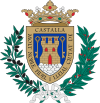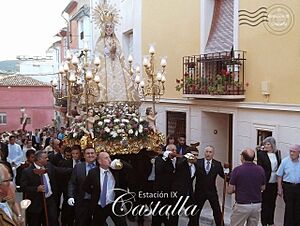Castalla facts for kids
Quick facts for kids
Castalla
|
|||
|---|---|---|---|

Church of the Assumption, Hermitage of Blood and Castle
|
|||
|
|||
| Country | |||
| Autonomous community | |||
| Province | Alicante | ||
| Comarca | Alcoià | ||
| Judicial district | Alcoy | ||
| Area | |||
| • Total | 114.6 km2 (44.2 sq mi) | ||
| Elevation | 675 m (2,215 ft) | ||
| Population
(2018)
|
|||
| • Total | 9,880 | ||
| • Density | 86.21/km2 (223.29/sq mi) | ||
| Demonym(s) | Castelluts i castelludes | ||
| Time zone | UTC+1 (CET) | ||
| • Summer (DST) | UTC+2 (CEST) | ||
| Postal code |
03420
|
||
| Official language(s) | Valencian, Spanish | ||
Castalla is a town in Spain. It is located in a region called Alcoià. This area is part of the Alicante province. Castalla sits in the mountains, about 35 kilometers (22 miles) from the city of Alicante.
Contents
Exploring Castalla's Location
Castalla Castle stands on a hill. It looks over a valley and the town below. The town is about 680 meters (2,230 feet) above sea level. The valley, known as Castalla La Hoya, is shaped like a "T". It is surrounded by mountains like Maigmó (1296 m), Cati (1260 m), and Argenya (1230 m).
The weather here is like a mid-mountain Mediterranean climate. The average temperature is around 17 degrees Celsius (63°F). It does not rain a lot, about 400mm (16 inches) per year. But the mountains can bring more clouds and rain. Snow often falls in January and February.
You can reach Castalla from Alicante and Valencia using the A-7 highway.
The castle has a long history. People lived there in the Stone Age and Bronze Age. Later, the Iberians, Romans, and Arabs also used it. The Romans called it "Castra Alta," meaning "high strength." The castle has always been the center of the town.
Castalla's Rich History
Early Times and the Castle
In 1244, King James I of Aragon took the castle from the Moors. He made Castalla part of the Kingdom of Valencia. At that time, Castalla was on the border with Castile. Because of this, the castle was rebuilt. The first church was also built where the Chapel of the Blood is today.
For a long time, Castalla was owned by a lord. But in 1336, King Pedro IV of Aragon made it property of the Crown. Later, in 1362, the Barony of Castalla was created. It was given to Don Ramon de Vilanova. The castle was passed down through families. In 1729, it went to the Marquis de Dos Aguas. Finally, in 1989, the town of Castalla bought the castle.
Wars and Royal Honors
During the War of Succession, Castalla supported Philip V. After the war, Philip V gave the town special rights. He also gave it the title "Very Noble and Loyal Faithful."
Castalla was also important during the War of Independence. Two big battles happened here. The First Battle of Castalla was on July 21, 1812. The Spanish army lost this battle. But the Second Battle of Castalla, on April 13, 1813, was a victory. The Spanish and British armies defeated the French. A Spanish group led by Samuel Ford Whittingham fought very bravely.
In 1890, Queen Regent Maria Cristina gave Castalla the title of "City."
Economy and Festivals
Castalla's economy relies on farming. Farmers grow almonds, olives, and grapes. The town also has industries. These include making toys, construction materials, furniture, and textiles.
Every September, Castalla celebrates the Moros i Cristians festival. It is a colorful event that remembers the town's history.
Main Sights to See
Castalla has many interesting places to visit:
- The hilltop walled castle, built in the 11th century.
- The Hermitage of the Blood, from the 13th century.
- The Catholic church of la Assumpció, built in the 16th century.
- The Renaissance style town hall, from the mid-17th century.
- The Estación IX. This is the ninth stop on the "Route of the Cross." This is a special walk that happens every Easter.
See also
 In Spanish: Castalla para niños
In Spanish: Castalla para niños





